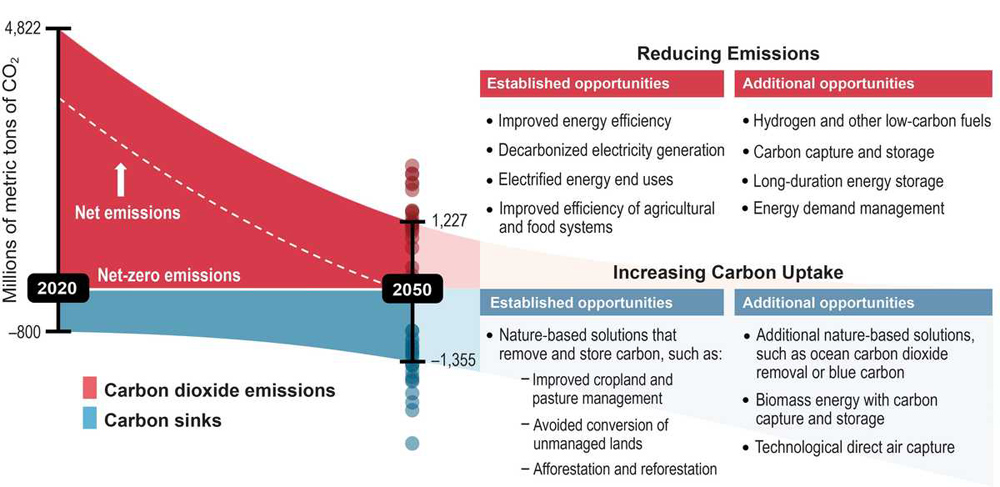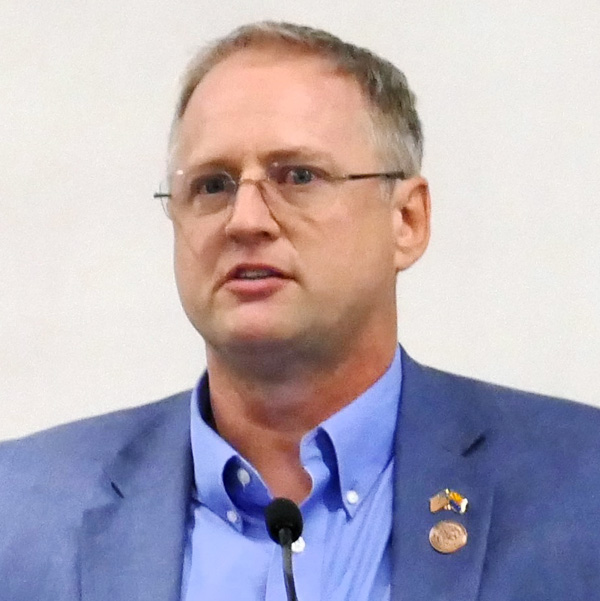A key difference between the draft National Transmission Needs Study the Department of Energy released in February and the final version issued Oct. 30 is a new section in the introduction spelling out what the goals of the report are and, equally important, what they are not.
“The objective is to identify pressing transmission needs across the nation,” said Jesse Schneider, a policy adviser in DOE’s Grid Deployment Office (GDO), which authored the report. “However, the study does not prescribe any specific transmission solutions to meet those needs.”
Speaking during a recent webinar on the report, Schneider further stressed “the study findings are intended to inform department transmission priorities, including implementation of funding programs, technical assistance or broader transmission planning programs.” The report is not intended “to supplant or presuppose any existing transmission planning activities,” he said.
Similarly, while the study does break down transmission needs by region, that analysis will be used to “inform” but not designate any National Interest Electric Transmission Corridors (NIETCs) ― areas where transmission constraints and congestion could be improved with federal funding and accelerated permitting. (See What Are National Interest Transmission Corridors and Why Do We Need Them?)
DOE issued a request for information on the process for designating NIETCs in May and, as with the Needs Study draft, received a range of comments. In her opening remarks at the Nov. 8 webinar, GDO Director Maria Robinson said further guidance on NIETC designation would be released by the end of the year. (See States, RTOs Caution DOE on Transmission Corridors.)
Separate from NIETCs, DOE sees the Needs Study as a resource that can be used to encourage entities “to revise their planning processes to incorporate these findings, including consideration of a wider range of transmission benefits [and] portfolios of transmission project evaluation, rather than individual project evaluation,” Schneider said.
Broader planning perspectives also might include “scenario-based planning with longer time horizons to incorporate alternative transmission solutions including grid-enhancing technologies, as well as weather data [that] better reflect future extremes,” he said.
The need to explain the study’s goals and how it should and shouldn’t be used was raised by a number of the 58 groups and individuals who submitted a total of 330 comments on the draft Needs Study. The comments were summarized, with the department’s responses, in an 80-page appendix to the final.
The range of comments and the resulting revisions made to the final study reflect the complexities of grid planning as the U.S. generation mix moves toward cleaner, renewable resources.
“I think it does send a clear message,” said Rob Gramlich, president of industry consultant Grid Strategies. “It’s a well-done and thorough report citing many dozens of studies. So, I think, as a pure piece of analysis and information, it makes a very strong case. And it is from the Department of Energy, with the authority that entails … and is supported by all the national labs, so that gives it a lot more credibility than just a report.”
The study’s topline findings were no surprise, as Energy Secretary Jennifer Granholm said in a press call preceding the release. “We need to seriously build out transmission in order to improve reliability and resilience, and of course, to lower energy costs and relieve congestion on the grid.”
The study also finds “that of all the different configurations of transmission deployment, interregional transmission results in the largest benefits,” Schneider added during the Nov. 8 webinar, with the caveat that “transmission needs will shift over time.”
The Comments
The report’s broad and general approach — and the department’s insistence on not providing solutions — left some commenters dissatisfied. Utilities, RTOs and transmission developers all argued the report omitted projects and circumstances specific to their transmission planning and operations.
New York Transmission Owners (NYTO), a utility stakeholder group in NYISO, said the report should include four of its latest projects, which are aimed at alleviating price differentials between New York City and upstate areas, an issue raised in the draft.
PJM staunchly defended its performance during the winter storm of February 2021, commonly referred to as Winter Storm Uri, noting it provided “unprecedented amounts of power” to neighboring regions and that any limits in interregional transfers were due to “constraints in neighboring systems.”
ERCOT, on the other hand, urged DOE to treat the effects of Uri as outliers, asserting the report’s call for more interregional transmission to connect Texas to surrounding areas is overstated, given system upgrades it has undertaken since the storm.
DOE’s decision to base the report on existing studies, rather than fresh research ― and the resulting underlying assumptions ― was another flashpoint. While the draft referenced more than 50 reports, DOE was deluged with recommendations for other studies to be included, resulting in the final version reviewing and citing more than 100 reports.
Given the study’s strong focus on interregional transmission, the National Renewable Energy Laboratory’s Interconnections Seam Study ― which looked at the benefits of interregional connections ― was one of the more surprising omissions from the draft, but it was included in the final. Other additions include MISO’s Long-Range Transmission Planning Process and CAISO’s 2022-2023 Transmission Plan.
A lack of up-to-date information on transmission needs on tribal lands was another gap in the draft, according to comments from the Blue Lake Rancheria Tribe, in Northern California. In this case, DOE tapped a still-unpublished survey on tribal access to reliable electricity, which found an estimated 54,000 Native Americans, including Alaska Natives, live without electricity, the majority of them in the Navajo and Hopi nations.
Of those surveyed, 23% do not have access to a centralized power grid, and 65% said existing grid infrastructure could be extended to tribal lands, the report said in a new section on tribal transmission needs.
Multiple commenters also took issue with DOE’s base case for anticipating and modeling future transmission needs, predicting high levels of renewable energy coming onto the grid, but only moderate load growth. Consolidated Edison pointed to the potential effect on demand spurred by New York’s Climate Leadership and Community Protection Act as an example of ambitious state legislation that could drive load growth.
The law calls for New York to cut its greenhouse gas emissions 85% by 2050, with an interim goal of a 40% reduction by 2030.
Advocacy nonprofits similarly called for DOE to factor in the effect on renewable energy and load growth of the Inflation Reduction Act’s clean energy incentives and EPA’s vehicle emission standards, which are expected to accelerate adoption of electric vehicles.
The Edison Electric Institute (EEI) and Public Service Enterprise Group (PSEG) faulted DOE for not taking into account FERC’s proposed rules on transmission planning and cost allocation. According to the Needs Study, EEI argued the proposed reforms “will encourage efficient, cost-effective transmission investment.”
DOE responded to EEI and PSEG by noting the Needs Study is focused on the physical limitations of the transmission system, “not jurisdictional or regulatory limitations.” FERC rulemaking, therefore, is deemed “out of scope,” DOE said. The department does acknowledge the likely effect of state and federal law, adding modeling of high renewable, high load growth scenarios to the final report.
For example, the study shows the Plains region (roughly corresponding with SPP) would need up to 119% more regional transmission under a moderate load growth, high renewable scenario, but possibly over 400% more in a high load growth, high renewable case.
The Impact
As originally authorized in 2005 amendments to the Federal Power Act, the Transmission Needs Study was called the Transmission Congestion Study, looking only at congestion on the grid. But the Infrastructure Investment and Jobs Act (IIJA) expanded the scope of the report to encompass future needs as well as congestion.
As the first such report, the Needs Study was released as part of a series of DOE announcements of new transmission programs funded by the IIJA, highlighting the department’s role as a catalyst for transmission expansion. DOE is using $1.3 billion in IIJA funds to sign on as an anchor off-taker for three interstate transmission projects, chosen in part based on regional analyses in the Needs Study. (See DOE to Sign up as Off-taker for 3 Transmission Projects.)
DOE also recently awarded $3.46 billion in IIJA funds to 58 grid improvement projects, with the largest award, $464 million, going to five transmission lines in MISO and SPP’s joint targeted interconnection queue (JTIQ) portfolio. Reflecting the Needs Study’s call for a portfolio approach to grid planning, the projects are aimed at improving interregional connections and transfers along the MISO-SPP seams. (See DOE Announces $3.46B for Grid Resilience, Improvement Projects.)
The report’s effect outside the department seems more uncertain, especially given the strong regional and local bias in the comments.
On the one hand, the study’s regional profiles are one of its strong points, laying out where more regional and interregional transmission could improve resilience and bring low-cost renewable power to urban and other areas with high electricity rates.
The study’s approach here is aligned with how RTO grid planning appears to be evolving toward the portfolio approach DOE advocates, as seen in the MISO-SPP JTIQ projects and PJM’s Regional Transmission Expansion Plan Window 3 solicitation. That initiative resulted in PJM recommending a range of projects to expand its system for new renewable generation as fossil fuel plants retire. (See PJM Recommends $5B in RTEP Transmission Projects.)
But the study also notes the majority of transmission projects that have been built in recent years are smaller lines aimed at improving local reliability. The proportion of overall transmission installed to address system reliability needs has grown from 44% in 2011 to 74% in 2020. Interregional projects that can provide multiple benefits beyond reliability ― such as getting more cheap, renewable power online ― still face formidable obstacles, including permitting and financing.
Gramlich sees the report as one piece of an incremental process ― including DOE funding, NIETC designation and FERC rulemaking ― that could drive change in transmission planning, permitting and construction.
“The report could encourage state and federal regulators to get busy … with interregional [transmission],” he said. “It can also encourage private developers ― utilities or independent developers ― to work on lines. … I would think developers building in the transmission [regions] that were highlighted in the report would get a boost with all of the stakeholders and all the utility off-takers or other subscribers to transmission lines. I would think this report would be meaningful for them to encourage their participation.”

